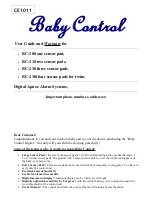
4
Section
Introduction to Touch Screens
Touch screen interfaces have become the standard interface in the past 5 years. They
are, rugged, reliable, extremely flexible and easier than ever to implement! The universal
acceptance of the Windows GUI [Graphical User Interface] along with the extensive use
of a mouse interface has significantly accelerated the use of a touch interface. Basically
think of your touch screen as if it were a mouse.
AutomationDirect.com touch systems are mouse emulators. By installing a software
driver and connecting to a serial port, the touch screen will support all the primary mouse
functions:
The FPM-170(-TS) touch screen interface, is a high resolution, analog resistive.
Following is a quick explanation of what all this means.
High Resolution: The touch screen resolution is 400 ppi [points per inch]
Analog Resistive: The actual touch glass is an analog device. Meaning there is a very
low voltage applied to the X and Y axis of the touch screen. This current is applied to
ITO [Iridium Tin Oxide] that is sputtered onto a polyester membrane. When you touch
the screen you are changing the resistance on both the X and Y axis, producing an
analog value that references a particular location.
This type of screen can be activated with a gloved finger or mechanical stylus.
The touch screen itself is connected to electronics [internal to the display unit] that
provide the Analog to Digital conversion. When the screen is touched, the electronics
convert the analog voltage to a digital value and add a "Mouse Click". This touch data is
sent out from the display serial port to the PC serial port where the touch driver presents
the data to the operating systems as if it were from a normal PC mouse. When the touch
is released the new XY location is sent along with a "Mouse Up Click".
The touch screen interface to the PC is RS-232, so the recommend maximum distance
from the PC is 50 feet., The driver and and interface have been tested to 50 Ft. using
high quality cables. High quaility cables and connectors are important, especially if field
connections are made. Poor quality cables will drastically reduce the performance of the
RS-232 interface. The touch driver default baud rate is 9600.
Touch Screen Setup and Configuration:
If the unit does not have a touch screen, your configuration is complete. If your display
is fitted with the optional touch screen interface, the following section will outline
installation and set up. This system requires no special software knowledge, and can be
installed and set up in minutes. The following section gives a detailed explanation of the
software setup and configuration
Touch Screen
Setup
Summary of Contents for FLI-150
Page 9: ...FLI 150 FLI 150 TS LCD Monitor User Guide Revised 12 02...
Page 28: ...Appendix D Mounting Dimentions...
Page 29: ......
Page 30: ...NOTES Model Number _________________ Serial Number _________________...
Page 31: ...FLI 180 FLI 180 TS LCD Monitor User Guide Revised 12 02...
Page 51: ...Appendix D Mounting Dimentions...
Page 52: ......
Page 53: ...NOTES Model Number _________________ Serial Number _________________...
Page 54: ...FPM 120 FPM 120 TS LCD Monitor User Guide Revised 12 02...
Page 74: ...Appendix D Mounting Dimentions...
Page 75: ......
Page 76: ...NOTES Model Number _________________ Serial Number _________________...
Page 77: ...FPM 150 FPM 150 TS LCD Monitor User Guide Revised 12 02...
Page 96: ...Appendix D Mounting Dimentions...
Page 97: ......
Page 98: ...NOTES Model Number _________________ Serial Number _________________...
Page 99: ...FPM 170 FPM 170 TS LCD Monitor User Guide Revised 12 02...
Page 119: ...Appendix G Mounting Dimentions...
Page 120: ......
Page 121: ...NOTES Model Number _________________ Serial Number _________________...
Page 123: ...FPM 180 FPM 180 TS LCD Monitor User Guide Revised 12 02...
Page 143: ...Appendix G Mounting Dimentions...
Page 144: ......
Page 145: ...NOTES Model Number _________________ Serial Number _________________...
















































